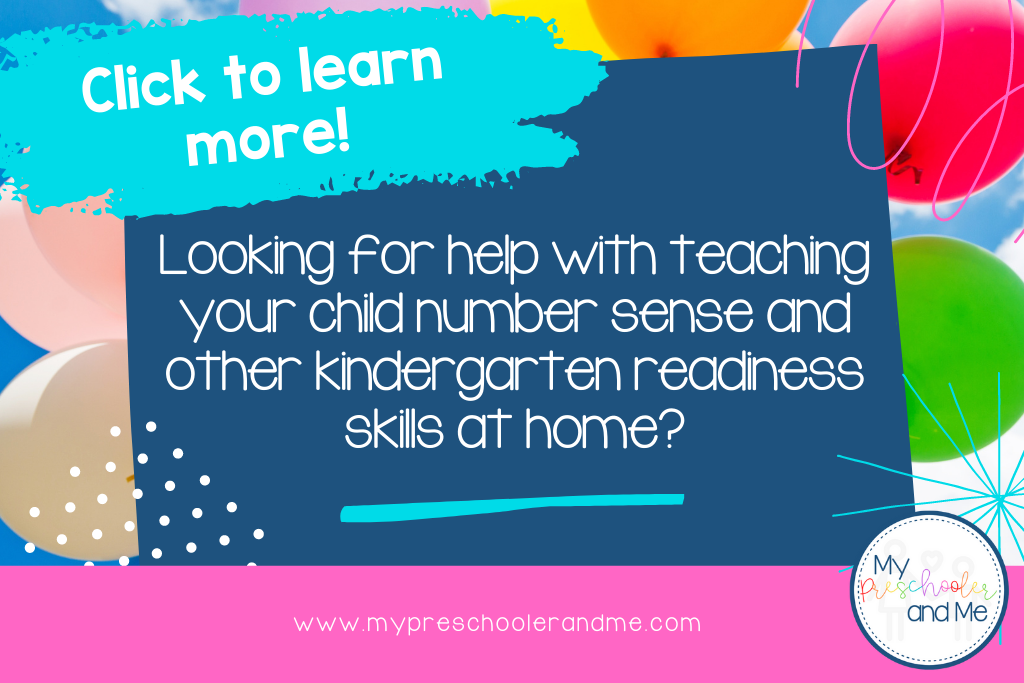
Can Having a Strong Number Sense Help Your Preschooler Avoid Math Anxiety?
Have you ever thought about how important having a strong number sense is for your preschooler? You might not realize it, but number sense plays a huge part in a child's success in math.
I want you to think back to your time in elementary school math class. I'm sure there are a handful of you reading this now who loved and even excelled in mathematics. However, if you're anything like me, math was something that gave you GREAT anxiety.
To this day, if I'm asked a question that requires me to do mental math in front of another person, I can feel my face turn red and my palms begin to sweat. It’s a terrible feeling!
As a former teacher, my personal experiences with math got me thinking. How can I help other parents begin setting a firm foundation of mathematical skills for their preschoolers? The answer–encourage strong number sense.
If you think about it, it just makes sense. Everything we learn in math begins with number sense. For young children, number sense starts with learning to count.
Next, children learn to recognize the shapes and names of familiar numbers. Finally, they begin to represent these numbers with objects and some children begin manipulating number parts.
The good news is that if we start working with our preschoolers now, we can help our children develop a strong mathematical foundation that comes without anxiety. Want to know where to start today?
Download your free guide that outlines six things you can start doing with your child right now to help build strong number sense. Click here to get your free copy now.
What is a number sense?

What do you think of when you hear the term number sense? Most people would say that it has to do with how well or how high their child can count. Counting is definitely part of it, but true number sense goes way beyond the ability to count.
In order for us to help our children lay a strong foundation in math, we as preschool parents must first have an understanding of number sense ourselves.
The term number sense refers to how well a child understands the different ways in which numbers can be broken down, put together, and manipulated within the context of a math problem.
Wow! That might sound pretty complicated, but in short, number sense really just refers to a child’s understanding of number relationships in the world around him.

At the preschool level, this might look like children learning to count one object at a time using one touch for each object. While playing at the block center, a group of preschools may build two block towers and then compare their heights to determine which is the tallest and which is the shortest.
Children may also begin recognizing that there are two fish in the classroom tank instead of needing to count each fish every time the child looks inside.
Don’t stress. It’s important to remember that children build upon their number sense skills all throughout their school-age years. There are also several different activities that you can do now with your child to help lay a strong math foundation that will grow with your child. We will discuss those activities soon.
Real quick–Did you grab your free guide? It outlines six things you can start doing right now with your preschooler to help build strong number sense skills. You can find the guide here.
Why is number sense so important?
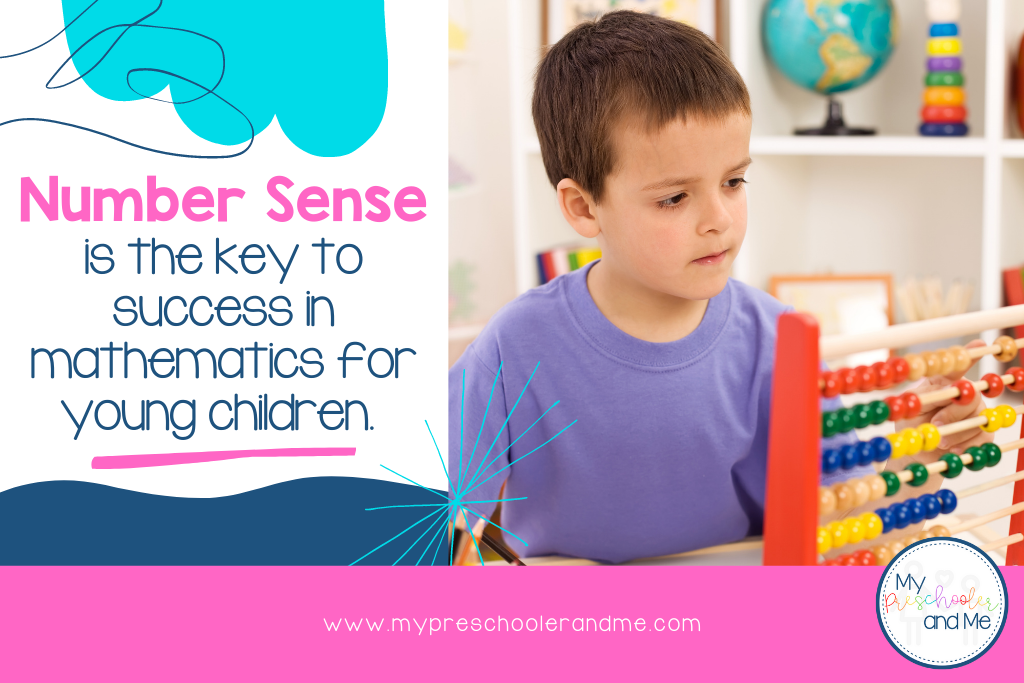
Number sense is important because it is the key to success in mathematics for children. As I’m writing this, many past student faces are coming to my memory.
Within every class, I always had a few children who could manipulate numbers beyond their years. Math just seemed to come naturally to them.
The majority of my students would come to me on or just above grade level. However, in addition to those two groups, I always had a handful of students who really had to work hard to get their math skills on grade level.
These three groups of children came to me with widely different experiences in math. It was obvious to me which children had been exposed to math skills and number sense activities at a very young age.
On the flip side, it was also very obvious to me which children were not as exposed to mathematical thinking or who just didn’t quite possess a solid number sense foundation yet.
So, why do we put so much emphasis on the importance of number sense and young children? Well, there are many answers to this question which we will explore further now.
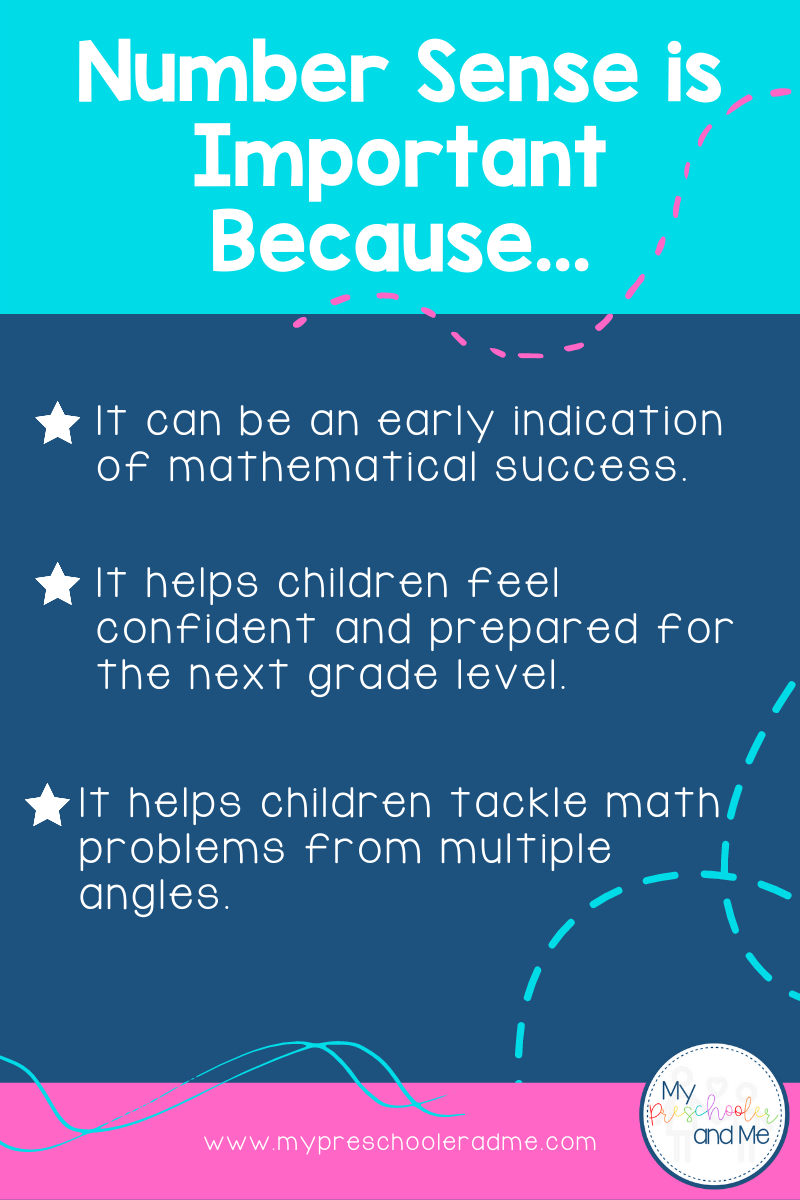
Number sense can be an early indication of mathematical success.
If you think about it, that really does make sense. Number sense in preschool essentially lays the foundation for future math learning.
As children progress through school, they continue to build upon previous math skills and knowledge. The stronger the foundation for mathematical learning on which to build, the least likely it will be for that child to “get stuck” or encounter issues that provoke intense struggle along the way.
Number sense helps children feel confident and prepared for the next grade level.
One of the main reasons for this is because when taught correctly, number sense becomes a natural part of a child’s everyday life. Math skills aren’t something we only use in school during math class. Instead, number sense is an ingrained way of thinking about math and numbers throughout everyday living.
Number sense provides children with "multiple tools for their math toolbox."
What I mean by this is that as children are solving math problems, they’re able to look at numbers as many different parts and pieces instead of just as one set whole.
As children mature, they learn to take parts of numbers and put them together with other numbers to create new quantities. They are also able to look at math problems and solve them using multiple strategies.
What is early number sense?

We’ve talked a lot about what number sense is in general. Let’s take a closer look at what it might look like from a preschooler’s perspective.
In preschool, whether that be at home or within the classroom setting, we lay the foundation for a variety of mathematical concepts. Here are some of the mathematical concepts that preschoolers learn and practice throughout their preschool year(s):
- Number Identification
- One-to-One Correspondence
- Subitizing
- Rote Counting
- Patterns
- Sorting
- More or Fewer
- Capacity
- Simple Addition/Subtraction
- Shapes
- Graphing
- Measurement
Number Identification
Children start by becoming familiar with the shape of each number. Over time, preschoolers begin to learn the correct name for each number. Most preschool-age children focus on numbers 1-10 or 1-20.
One-to-One Correspondence
One-to-one correspondence (or 1:1 Correspondence) is used when children count objects independently. When children use one-to-one correspondence, they are using one touch per object as they say one number aloud.
When a child has strong one-to-one correspondence, he or she can determine the exact amount of objects in a set. The child understands that the set has no more and no less than the number said last while counting. This is also referred to as cardinality. Preschoolers develop this skill with practice and maturity throughout the year.
Subitizing
Subitizing is the ability to “see” a number without counting it. Think about a dice. When you roll a number three, you don’t need to count the dots each time.
Your brain has learned that when the dots are in that same diagonal pattern on a dice, that means there are three dots total. In preschool, we begin introducing subitizing with smaller quantities.
Rote Counting
Counting is a large part of preschool. Children are encouraged to count as they play both indoors and outdoors.
Counting is one of the first steps in number sense that preschoolers begin practicing. They will continue to build upon this skill as they mature.
Patterns
Preschoolers love to complete simple patterns. Some children even begin to create their own patterns out of cars or art supplies. Patterns in preschool can be as simple as a child noticing the clouds in the sky or as complex as a child building and creating a fence from repeating blocks in the block center.

Sorting
Preschoolers are naturally curious. Most are also naturally observant, so you might see children initiate sorting without adult prompting. Preschoolers work on sorting by color and shape and move on to more complex attributes with maturity.
More advanced sorting might include the child looking at a group of objects and then independently determining the attribute of which to sort them.
An example of this would be sorting shells. There are lots of different ways in which the shells could be sorted. It’s up to the child to determine how that should be done.
More or Fewer
As young children mature, they begin to develop the ability to compare two sets of similar objects. They learn to determine which set has more and which set has fewer objects. In elementary school, this skill will transition into greater than and less than numbers and activities.
Capacity
Capacity is very fun for children to explore. Preschoolers love to fill cups and buckets and can be prompted to determine which cup holds the most (or least) amount of objects or liquid. Capacity can be explored during both indoor and outdoor play.
Simple Addition/Subtraction
Preschoolers love to complete simple math problems. Young children can be introduced to simple addition and subtraction as they play.
Imagine a child pretending to bake cookies for a friend. The teacher or parent could pose this question to the child: “If you have three cookies on your plate and Samantha eats one of them, how many would you have left?” The child and caregiver could then discuss and even act out this scenario together to find the answer.
Shapes
Preschoolers are very interested in learning about shapes. In preschool, we discuss basic shape attributes such as sides and points. We also learn the different shape names.
Older preschool children may practice drawing basic shapes on paper. Learning about shapes helps lay the foundation for geometry. Children love to search for shapes in the world around them.
Graphing
Graphing might seem like a skill for older children, but preschoolers are fully capable of completing basic graphing activities. Here is one you could try at home with your child.
You will need a small bag or handful of rainbow goldfish crackers. Have your child sort the fish into piles by color. Then, give your child a copy of the graphing sheet found here.
Have your child place the goldfish in the correct columns on the graph. Ask your child questions about his/her graph. Download your free rainbow goldfish cracker graphing activity.
Measurement
Preschoolers love to measure things using nontraditional standards of measurement. Children could use their shoes, pencils, Barbie dolls, cars, etc. to measure objects in their houses or around their classrooms.
How do I teach my child number sense?
The entire concept of number sense can be very overwhelming. However, it’s important to remember that developing number sense in children is not an overnight process nor is it something you have to have mastered by the time your child enters kindergarten.
Keep in mind that your child is going to be learning number sense concepts all throughout elementary school. So, what can we do now as parents to help our children develop a strong number sense?
There is no right or wrong way to teach your child number sense. However, preschoolers learn best through playful, fun activities that don’t really feel like actual work to them. Let’s dive into some ideas for fostering this type of learning.

Rote Counting Number Sense Activities
Rote counting is just that–counting. Next time you are in the car with your child, practice counting out loud together. You can count at the grocery store, at the park, or at the doctor’s office.
Rote Counting Practice
Try some of these exercises to keep counting fun.
- Sing the numbers in a silly way.
- Go back and forth saying the numbers together. Start by saying "one." Have your child say "two." Continue like so.
- Count using different silly voices.
- Have your child clap his hands or pat her legs each time they say a number.
- Pat a set of sticks together each time your child says a number.
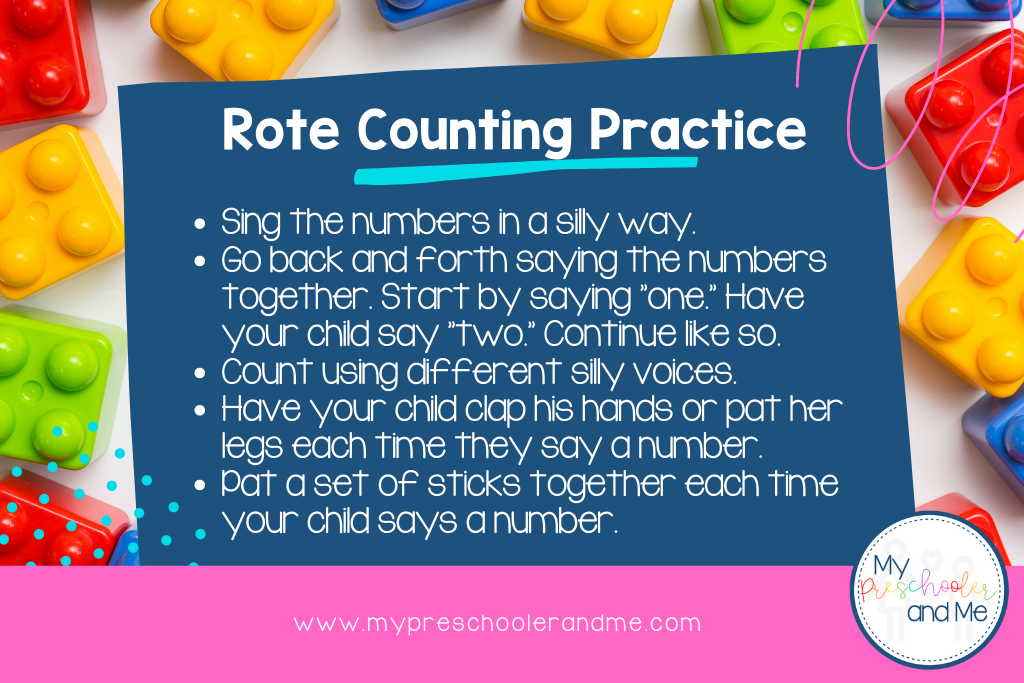
Number Identification Number Sense Activities
After children learn to count out loud, they often begin recognizing the shape of numbers when written. As children begin to associate the number “3” with the written or spoken word “three,” it doesn’t necessarily mean that the child understands the value of the number three just yet.
Number identification (also known as number recognition) just refers to when children can look at a specific number and tell you its name.
Number Identification Practice
You can practice number identification with your child during your daily routines. Try some of these ideas:
- Pick a “number of the day.” As you go about your daily routine, have your child be on the lookout for the number. Have him tell you each time he sees the number.
- Read books about numbers to your child. Identify the numbers found on each page. Tina over at Teach the TK Way has a great book list for books involving numbers.
- Look at the tag on your child’s clothes together as your child is dressing for the day. Talk about what size clothing your child wears.

One-to-One Correspondence Number Sense Activities
Once your child has had plenty of practice with rote counting and number identification, you will start to see him transition into representing these numbers with objects. This skill is called one-to-one correspondence, or 1:1 correspondence.
An example of this would be a child playing with four stuffed animals. The child may count the stuffed animals and run to tell his mom that he has four teddy bears.
This child made the connection between the number’s name and its actual value. This is also an indication that this child may understand cardinality.
One-To-One Correspondence Practice
Here are some ways in which you can encourage one-to-one correspondence skills.
- Play Play-Doh together. Create five balls of Play-Doh and set them in front of our child. Ask your child to smash three of them. Repeat using new numbers.
- While playing together, ask your child to send four cars down the ramp. Repeat and request a new number of cars next time.
- During lunch, talk to your child about the food on his plate. Ask your child to tell you how many chicken nuggets he sees. Now, ask him how many grapes he has.
- Have your child help you set the table for dinner. Help your child determine how many places you will need at the table for each member of your family. Then, count out the plates, cups, napkins, and silverware together. Avoid sharp objects such as knives.
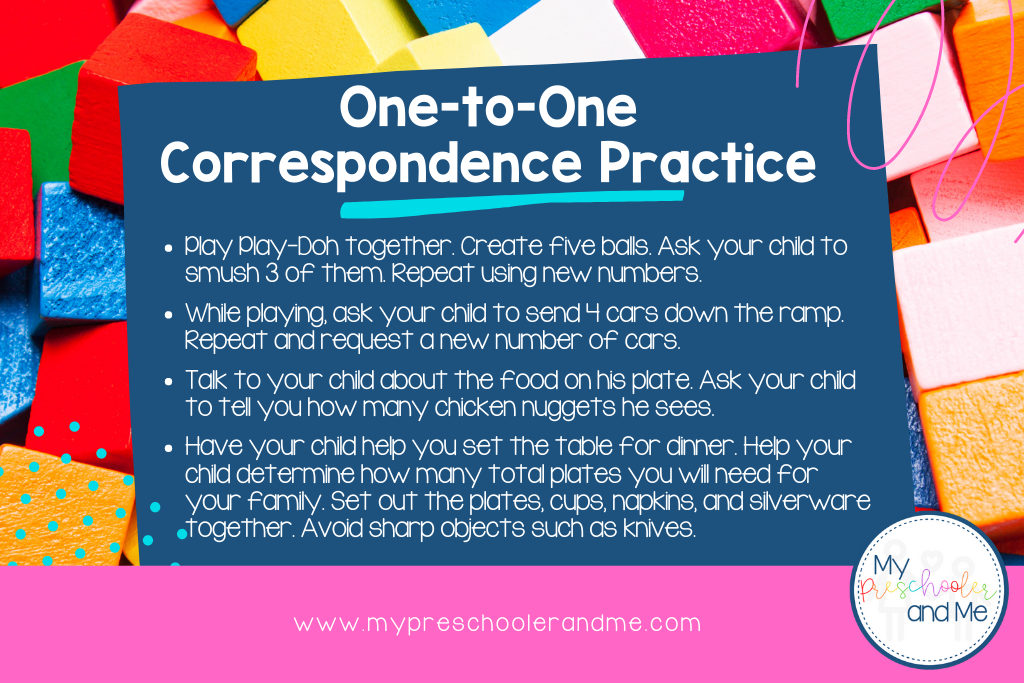
Subitizing Number Sense Activities
Subitizing might be a new term for you. There's a pretty good chance that you're more familiar with it than you may realize. Subitizing is the ability to look at a set and automatically know how many are in it.
As adults, we use this skill all the time throughout our day, but we might not even realize it. For example, if we’re playing a board game with a friend and roll the dice, we don’t have to count the number of dots on the dice each time in order to know how many spaces to move our piece. Our brain automatically knows or “sees” that number when we look at the dice.
Young children are working on developing this skill. At the preschool age, it looks a little bit different for them though. Here are real-life examples of when children might recognize subitizing.
- Children know that two socks make up a pair.
- Your child notices that most animals walk on four legs and humans walk on two.
- There are four wheels on mommy’s car.

Subitizing Practice
Children will continue to work on subitizing as they move through kindergarten and elementary school, but you can try these activities with your child at home for more practice.
- Download a free set of subitizing cards from Mrs. Males Masterpieces. Use these cards like flashcards with your child, but not all at once so your child isn’t overwhelmed.
- Here is a fun YouTube video from Harry Kindergarten Music. Play this video for your child and have him/her practice saying each quantity pictured.
- Grab your very own set of free forest animal clip cards from The Kindergarten Connection’s blog. Just cut and add clothespins and you are ready to go.
Composing and Decomposing Numbers Number Sense
Put simply, composing and decomposing numbers is addition and subtraction. In preschool, we teach a simplified version of this. Math symbols are rarely if ever used, so the focus is on having the children learn to manipulate numbers. The symbols will come later in kindergarten.
When a child composes a number, it’s the same as addition. The child takes two different parts and puts them together to make a new whole. Decomposing a number is the same as subtraction. The child takes a whole number and breaks it into new parts.
The best approach to addition and subtraction in preschool should be to keep it simple. Preschoolers should not be attempting to complete paper and pencil addition and subtraction problems unless your child simply enjoys doing that.
Composing and Decomposing Numbers Practice
For more addition and subtraction practice, try these activities at home with your child:
- Have math chats together. As you are strolling through the grocery store, ask your child to help you bag three oranges and two pears. Then ask your child how many pieces are in the bag now.
- During dinner, have your child tell you how many apple slices they would have left if they gave two slices to you.
- Use a five frame with your child. Start by covering two spots on the board with one color. Have your child see how many spots are left to fill in with a new color. When you use two color groups, your child can easily see the two groups that make up all 5 objects.
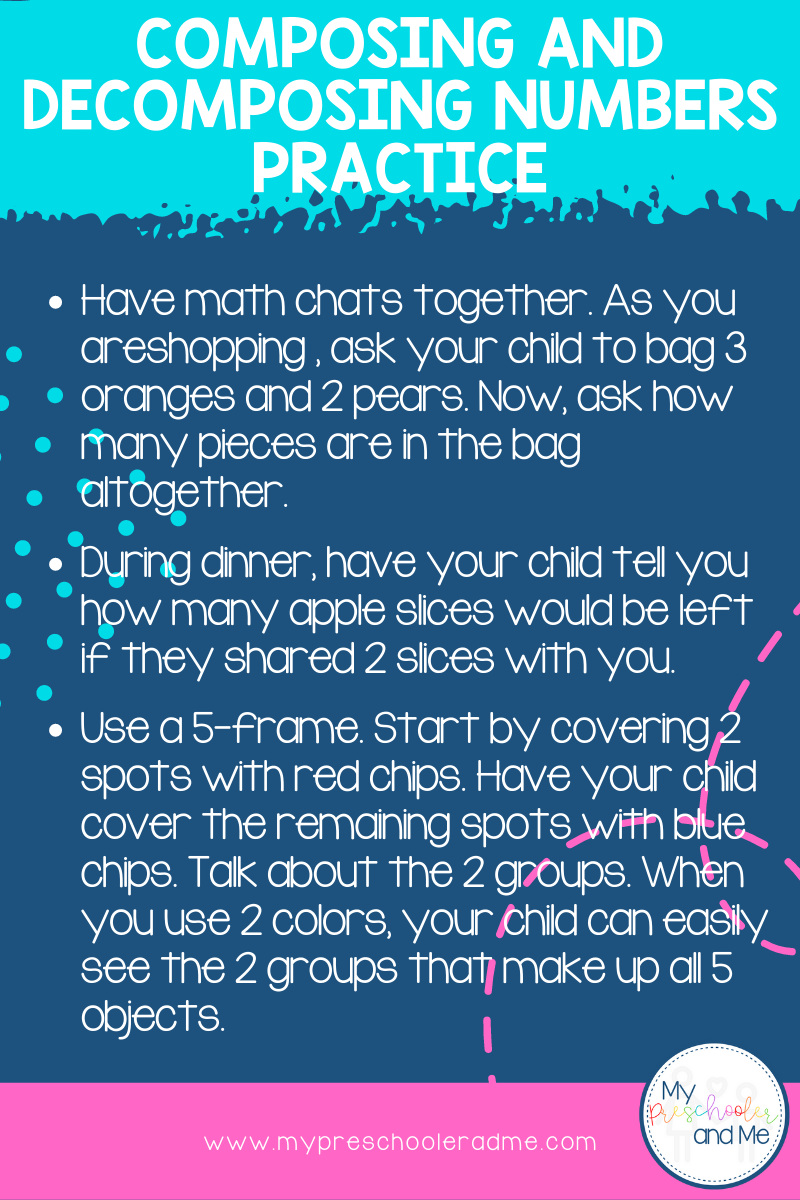
Teaching Number Sense Skills Simplified
Number sense can be an intimidating subject for parents and teachers alike. The important thing to remember is that whatever we do now to support our children’s mathematical growth can and will make a big impact on our child’s future experiences in math.
Remember, the process doesn’t have to be complicated in order to be effective.
Are you looking for help with teaching your child number sense and other kindergarten readiness skills at home? Check out the My Preschooler And Me Membership. We help you take the guesswork out of preparing your child for kindergarten.
You receive professional quality training to go along with all learning materials so you can rest assured that your child is being taught the necessary skills for kindergarten success.
No more searching the internet for preschool ideas and lessons (unless you want to, of course). Everything is neatly organized inside our portal for your convenience.
The membership gives you your time back so you can focus on delivering good, quality instruction and attention to your child.
Don’t miss your opportunity to join the membership when it’s open. Reserve your spot on the waitlist today by clicking here. We hope to see you there. The possibilities for fun are endless!
Happy Teaching!
